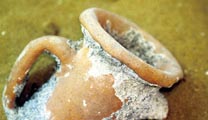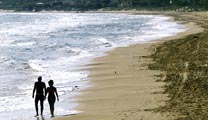| CULTURAL AND RECREATIONAL FACILITIES |
||
 |
 |
|
in Castellammare |
||
| |
||
| Beaches in the vicinity | ||
The port itself has a small sandy
beach. A short distance to the east of the town, you can find long sandy
beaches just 15 minutes away on foot or 5 minutes by car. In the summer
months there are several private bathing areas providing deckchairs
and sunshades in addition to public beaches. The spring or the autumn
is the best time for long strolls along the beach. |
||
| Hiking areas | ||
| Sicily’s oldest nature reserve, the Parco dello Zingaro, is located between Castellammare and San Vito lo Capo to the north. You will reach the southern entrance to the park if you drive in the direction of Scopello. It is now up to you to explore the park on foot. It is ideal for lengthy walks and for swimming as there are many tiny bays with emerald green water within the park that invite to linger and have a swim or sunbathe. The splendid view over the Gulf of Castellammare and the interesting flora (in the spring) will make your hikes an unforgettable experience. | ||
| Restaurants, Pizzerie und Kneipen in Castellammare | ||
| L'approdo | Fish and Pizza | |
| La Duchessa | Pizza | |
| Skipper | Bar, left an the port | |
| Vogue | Bar, right on the port, meeting point for joung people at the evening | |
| Thermal baths near Castellammare | ||
| Just 10-15 minutes away you can find
two thermal baths, both of which are fed by the same sulphurated water
(water temperature approx. 37°C). Terme Gorga: This unassuming thermal bath is open all year round (daily until about 11pm). It has a swimming pool and another small pool with warmer water. Take the motorway in the direction of Trapani. When joining the motorway at Castellammare simply take the next exit. Go right at the T-junction, underneath the major road and then it is signposted. Terme Segestane: If you take the old major road to Segesta, you will automatically come to these thermal baths after several kilometres (to the left just below the road). |
||
| Ancient Segesta, temple and theatre | ||
| You can reach the ancient town of Segesta via the Palermo-Trapani motorway (A29 and A29 dir.) in about 15 minutes. The former town of the Elami (who came from the region of Troy) is known for its Greek theatre up on the Monte Barbara, which affords a wonderful view over the hills over to the Gulf of Castellammare. One of the best preserved Doric temples is located below the Acropolis and embedded in the hills. | ||
| Selinunte, bears witness to the Greek's addiction to pomp and splendour! | ||
| Selinunte was once one of the flourishing Greek city states along the south-west coast of Sicily. The archaeological park can be accessed via the A29, which runs from Alcamo to Castelvetrano (approx. 40 minutes by car). This vast area is ideal for long walks from one temple to another. The reconstructed temples of the “Ancient Greeks” are instated here high above the shimmering turquoise sea. For a perfect end to your day, enjoy a swim or sunbathe on one of the sandy beaches of Selinunte. What is more: you can enjoy excellent fish dishes in Marinella dei Selinunte, just below the temple and right on the sea front. | ||
| Erice, up and away | ||
| The charming mountain village of Erice lies on high ground at some 700m, directly above Trapani. The view over to the Egadi Islands in the west, to the salines south of Trapani or to the bizarre coastline towards San Vito makes it worth visiting – providing mist does not hide it from view. If that is unfortunately the case, you can always console yourself with some delicious almond biscuits at Michele’s in the Bar Tulipano or at Maria’s! | ||
| The Phoenician island of Mozia | ||
| The Phoenician island of Mozia is just off the coast of Marsala. It was bought by an English amateur archaeologist at the beginning of the 20th century and has remained private property until today. You can reach the island by a small boat from the salines of Marsala and then stroll over the completely flat, relatively modestly sized island and admire the archaeological findings to date. One of the most interesting sculptures of the Phoenician age awaits you in the small museum. | ||
| Marsala, the home of the captivating Marsala wine | ||
| It is not far to Marsala which is famous for its sweet Marsala wine. It was an Englishman who initiated the production of Marsala in the late 18th century that was to bring prosperity to this small town. The clearly structured archaeological museum along the promenade is known for the relics of a Phoenician ship. Take a stroll through the old quarters of Marsala and see the numerous palaces and churches that have been refurbished in recent years. | ||
| Mazara del Vallo, the fascination of lost treasure | ||
| Mazara del Vallo, which boasts one the largest fishing fleets in Italy, is located only 20km from Marsala. A visit to the recently opened museum of marine archaeology close to the port alone would justify having a look at this pretty little town. The centre of the museum, previously a church, houses a dancing satyr which was found off the coast of Mazara and is one of the most impressive sculptures of Greek Hellenism. | ||
| The capital Palermo and the mosaics of Monreale | ||
| The fascinating city of Palermo with
its some 700,000 inhabitants, is the largest city in Italy. You can still
notice and feel its oriental history. Thanks to Leoluca Orlando, the then
mayor, Palermo enjoyed its “spring” and now belongs to the
citizens again. A stroll through the old city quarters round the so-called
Quattro Canti will guarantee a thrilling experience. Numerous baroque
palaces have already been refurbished, and the Teatro Massimo, one of
the largest opera houses, is again open for great musical events. Works of art from the Arab-Norman period are among the special attractions. They include the Cappella Palatina in the Norman Palace, San Giovanni degli Eremiti, the small church of La Martorana, San Cataldo and the hunting castle of La Zisa. You can visit the highlight of this epoch in Monreale, which is just above Palermo. This cathedral, full of Byzantine mosaics, resembles a medieval Comique and the charming cloisters are like paradise on earth. Those who prefer shopping will not be disappointed with Palermo either: upmarket boutiques can be found around the Via della Libertà, while more reasonably priced ones are located down towards the Via Maqueda and in the Via Roma. Visitors who love markets will be spoilt for choice: the traditional Vuccerie, the popular Ballarò and the Capo, with its almost oriental flair where there is nothing you cannot buy! |
||